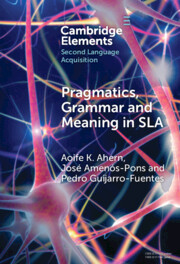206 results
The language of mechanical support in children: Is it “Sticking,” “Hanging,” or simply “On”?
-
- Journal:
- Journal of Child Language , First View
- Published online by Cambridge University Press:
- 17 March 2025, pp. 1-20
-
- Article
-
- You have access
- Open access
- HTML
- Export citation
2 - Structure Removal
-
- Book:
- German Syntax
- Published online:
- 28 February 2025
- Print publication:
- 06 March 2025, pp 88-111
-
- Chapter
- Export citation

An Introduction to Classical and Modal Logics
- The Outlines of Knowledge
-
- Published online:
- 08 February 2025
- Print publication:
- 21 November 2024
-
- Textbook
- Export citation
17 - Constructions in Typological and Cross-Linguistic Context
- from Part V - Constructions in Sociocultural and Typological Variation
-
-
- Book:
- The Cambridge Handbook of Construction Grammar
- Published online:
- 30 January 2025
- Print publication:
- 06 February 2025, pp 439-468
-
- Chapter
- Export citation
Understanding the meanings of ambiguous noun-noun compounds
-
- Journal:
- English Today , First View
- Published online by Cambridge University Press:
- 30 January 2025, pp. 1-8
-
- Article
- Export citation
Semantic information boosts the acquisition of a novel grammatical system in different presentation formats
-
- Journal:
- Language and Cognition / Volume 17 / 2025
- Published online by Cambridge University Press:
- 28 January 2025, e30
-
- Article
-
- You have access
- Open access
- HTML
- Export citation
Chapter 6 - The Language Problem
-
- Book:
- Otto Neurath in Britain
- Published online:
- 09 January 2025
- Print publication:
- 23 January 2025, pp 154-178
-
- Chapter
- Export citation
4 - Zipf’s Law of Meaning: The Degree Distribution of the Mind
- from Part II - Language
-
- Book:
- Behavioral Network Science
- Published online:
- 08 November 2024
- Print publication:
- 19 December 2024, pp 63-74
-
- Chapter
- Export citation
Chapter 23 - Linguistics and Philology in Dictionaries
- from Part IV - Dictionaries and Domains of Use
-
-
- Book:
- The Cambridge Handbook of the Dictionary
- Published online:
- 19 October 2024
- Print publication:
- 31 October 2024, pp 460-480
-
- Chapter
- Export citation
Topic aware probing: From sentence length prediction to idiom identification how reliant are neural language models on topic?
-
- Journal:
- Natural Language Processing ,
- Published online by Cambridge University Press:
- 25 October 2024, pp. 1-29
-
- Article
-
- You have access
- Open access
- HTML
- Export citation
Irrealis as modality: evidence from Gιsιɖa Anii
-
- Journal:
- Journal of Linguistics , First View
- Published online by Cambridge University Press:
- 24 October 2024, pp. 1-30
-
- Article
-
- You have access
- Open access
- HTML
- Export citation
Why more and less are never adverbs
-
- Journal:
- Journal of Linguistics , First View
- Published online by Cambridge University Press:
- 04 October 2024, pp. 1-29
-
- Article
-
- You have access
- Open access
- HTML
- Export citation
The ‘adverb-ly adjective’ construction in English: meanings, distribution and discourse functions
-
- Journal:
- English Language & Linguistics , First View
- Published online by Cambridge University Press:
- 27 September 2024, pp. 1-30
-
- Article
-
- You have access
- Open access
- HTML
- Export citation
Opaque morphology and phonology: Historical prefixes in English
-
- Journal:
- Journal of Linguistics , First View
- Published online by Cambridge University Press:
- 16 May 2024, pp. 1-33
-
- Article
-
- You have access
- Open access
- HTML
- Export citation
Development and validation of a nonverbal consensus-based semantic memory paradigm in patients with epilepsy
-
- Journal:
- Journal of the International Neuropsychological Society / Volume 30 / Issue 7 / August 2024
- Published online by Cambridge University Press:
- 15 April 2024, pp. 671-679
-
- Article
-
- You have access
- Open access
- HTML
- Export citation

Pragmatics, Grammar and Meaning in SLA
-
- Published online:
- 29 March 2024
- Print publication:
- 18 April 2024
-
- Element
- Export citation
Diagonal decision theory
-
- Journal:
- Economics & Philosophy / Volume 40 / Issue 2 / July 2024
- Published online by Cambridge University Press:
- 26 March 2024, pp. 485-496
-
- Article
-
- You have access
- Open access
- HTML
- Export citation
7 - Semantics and Pragmatics: Compositionality and the Relation between Grammar and Meaning
-
- Book:
- Modern Linguistics in Ancient India
- Published online:
- 14 March 2024
- Print publication:
- 21 March 2024, pp 165-187
-
- Chapter
- Export citation

The Logic of Entailment and its History
-
- Published online:
- 08 February 2024
- Print publication:
- 15 February 2024
5 - A Paradigm Change within Medieval Philosophy
-
-
- Book:
- Interpreting Buridan
- Published online:
- 01 February 2024
- Print publication:
- 08 February 2024, pp 69-87
-
- Chapter
- Export citation


